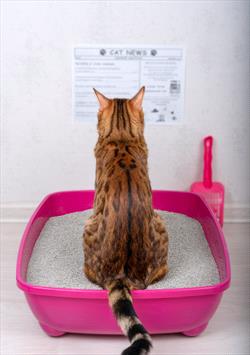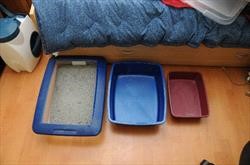Cats are low-maintenance and clean, making them appealing pets. Kittens instinctively know how to relieve themselves in soft materials and bury their waste, making it easy for them to learn to use a litterbox. Choosing and maintaining the right litterbox setup to meet your cat’s needs helps prevent house soiling and promotes healthy elimination behaviors from the start.

“Litter-training” Cats
At about three to four weeks old, kittens begin to play, explore, and dig in loose, soft materials like dirt or litter. This exploratory behavior soon leads them to eliminate in these areas. “Litter-training” a cat is not like house-training a dog. Taking a cat to the box and moving their paws in the litter is unnecessary and may create negative associations with the box or you. Instead, provide an acceptable, accessible litterbox based on the criteria described below, determining what is acceptable and accessible from the cat’s point of view, not yours.
Consider the following factors when setting up your litterbox for the best experience for you and your cat(s):
Size Matters
Bigger is better when it comes to litterbox size. Cats prefer a box with enough space to dig, cover their waste, and turn around without touching the sides. A general rule of thumb is that the box should be 1 1/2 times the length of the cat from their nose to the base of their tail.
Litter Depth and Type
Some caregivers believe that adding more litter reduces the need for frequent cleaning. Wild cats prefer areas with just a few loose particles for making small scrapes, not several inches of dirt. Therefore, two to three inches of litter is sufficient, allowing cats to cover their waste without sinking in. Long-haired cats may prefer even less litter or a smooth surface. A dirty litter box is a common reason for cats to eliminate outside the box, so adding extra litter does not replace the need for regular scooping and cleaning.
Most cats prefer fine-grained litter because it has a softer feel. Clumping litter is usually finer-grained than typical clay litter. High-quality, dust-free clay litter is also relatively small-grained and may be perfectly acceptable. Non-scented, clay-clumping litter is often the best choice, as some cats may not like crystals, pellets, or wood shavings.
Avoid changing types or brands once you find a litter your cat likes. Buying generic, the least expensive, or whatever brand is on sale may lead to problems. Some cat litter is developed more with the caregiver’s needs in mind rather than the cat’s. Many cats are put off by the smell of scented or odor-repellant litter, so placing a room deodorizer or air freshener near the litterbox might be objectionable. A thin layer of baking soda on the bottom of the litter box can help absorb odors without deterring the cat. If the litterbox is kept clean, odor should not be a problem.
Location is Key
Caregivers often place the litterbox in out-of-the-way locations to minimize odor and litter tracking around the house. Common placements include the basement, next to an appliance, in the garage, or on an unfinished, cold cement floor. While convenient for caregivers, these setups can be less than ideal from the cat’s perspective.
For example, young kittens may not be able to navigate long flights of steep stairs in time to use the bathroom, and newly introduced adult cats may initially forget where the box is located. Cats can also be startled if a furnace or washer-dryer suddenly turns on while they are using the box. Additionally, some cats prefer to scratch the area around their litterbox and may find a cold cement floor unappealing or uncomfortable.
To minimize the risk of your cat finding an alternative, more convenient toilet, always place litterboxes in quiet, low-traffic areas with easy access and escape routes. Make sure there is at least one box per level of the house, and keep them away from your cat’s food and water stations. One compromise is to place the box in a closet; if you do this, wedge the door open from both sides to prevent your cat from being trapped inside or outside. If the box is on a smooth, slick, or cold surface, consider placing a small throw rug underneath it.
Types of Litter Boxes
Litterboxes come in many shapes and sizes, and while larger is generally better, each cat may have individual preferences. Open boxes are typically preferred over covered boxes, although they provide less privacy. Hooded boxes offer privacy but can have poor air circulation, which might deter some cats. Self-cleaning boxes can be convenient but might scare others. Just like with location, offering different types of litterboxes helps cater to each cat’s unique needs.
How Many Boxes?
When it comes to the number of litterboxes, a good guideline is to follow the golden rule: number of cats + one. It is generally not possible to designate a personal, unique box for each cat, as cats will often use any and all available litterboxes. In multi-cat households, placing boxes in various locations around the house gives cats options if another box is occupied and prevents territorial disputes, bullying, or guarding of the box.

Maintenance
Litterboxes must be kept consistently clean. To meet the needs of the most discriminating cat, feces should be scooped out of the box daily. How often you change the litter depends on the number of cats and the number of boxes you have. Twice a week is a general guideline, but depending on the circumstances, the litter may need to be changed every other day or only once a week. If you notice an odor from the box or if much of the litter is wet or clumped, it is probably more than time for a change. Do not use strong-smelling chemicals or cleaning products when washing the box. The smell of vinegar, bleach, or pine cleaners may cause your cat to avoid the box. Washing with soap and water should be sufficient.
Liners
Some cats don’t mind having a liner in the box, while others do. You may need to see if your cat is bothered by a liner in the box. If you use a liner, make sure it is anchored in place well so it cannot easily catch your cat’s claws or be pulled down into the litter.
If Problems Develop
Elderly or arthritic cats might benefit from ramps or a lower-sided box. For cats that tend to kick litter out, use high-sided boxes and consider placing a litter-trapping mat under the box. Some cats might be sensitive to certain box materials or odors. If your cat stops using the litterbox, your first call should always be to your veterinarian. Many medical conditions can cause a change in litterbox habits, and these possibilities must be considered first. If your veterinarian determines your cat is healthy, the cause may be behavioral. When resolving house-soiling behavior in cats, environmental changes are often needed, and punishment is never the answer. For more assistance, contact a veterinary behaviorist or animal behavior professional who is knowledgeable and experienced in working with cats.

